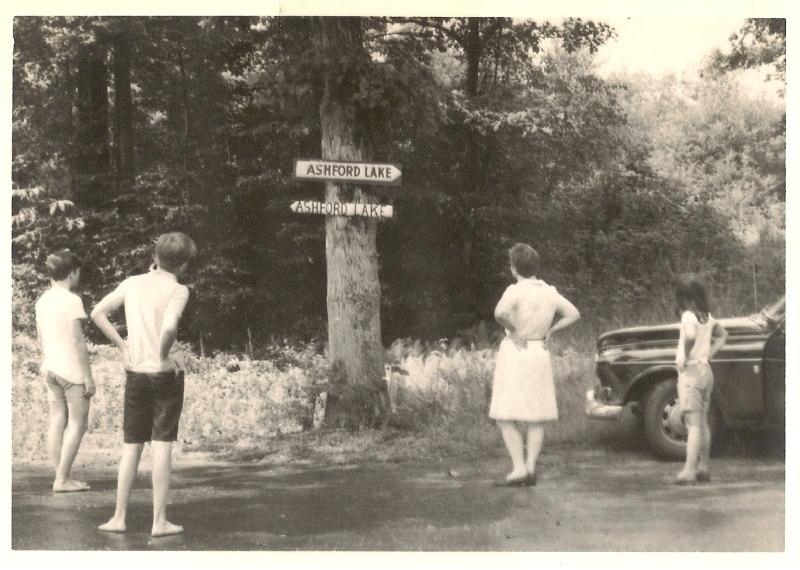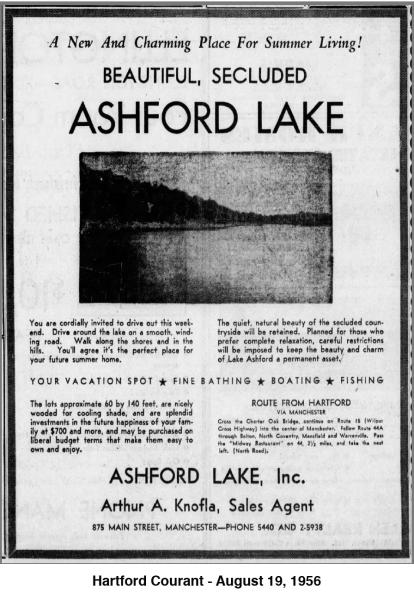ALPOA History
How to build a lake from scratch (PUTNAM TOWN CRIER - MARCH 13, 1998)
We are surrounded by lakes. To name a few is no problem. In Webster there is Webster Lake; Woodstock has Roseland Lake; Killingly has Alexander's Lake; Thompson has Quadick Lake. All have one thing in common... having provided excellent recreation and cottage sites for many. With these lakes, you can add a mixture of many smaller ponds, some large, others smaller. But they, like their big brother lakes, are still an important part of life in the area. The lake, which qualifies as the youngest, is Ashford Lake, a man-made facility which is somewhat of a wonder in engineering when one considers it was built from scratch?
The idea of having a lake on his property was a long-time dream of Joe Campert. In 1949 he started discussions with others and his 300 acres that lay partly in Ashford and partly in Eastford was destined to feature a lake. The man-made project is unique and one of only a few such projects attempted on a private scale. Campert and realtor friend, Arthur Knofia, studied the land and agreed it was a natural. It was a depression surrounded by acres of woodland, 60 or more acres to be used for Ashford Lake. This dream has become a project of not only Campert and Knofia, but of dozens of others in the area who envisioned a home development project around this new attraction.
A wide expanse of wooded area all sloping to a bason with a small stream of water running through it is what there was in the beginning. Many springs trickled into the depression and found the stream, which flowed into a swamp. The idea was to build a dam at the narrow southern end of the basin, and if enough water flowed from the springs, a large natural lake could be built at the spot.
The dam was built and was 385 feet long, 120 feet wide at the bottom and 26 feet wide at the top. There was enough water to create a lake one-half mile long and a quarter-mile wide. And there it nestles in the midst of the vast wooded area framed by a mixture of trees that all blend in.
The lake was a tremendous undertaking and Knofia entered into a contract with Campert to help raise money to help finance the project. Ray Malnor, an independent bulldozer operator, was hired and clearing the dam site was underway. The State Board of Supervision of Dams issued a permit to build the dam, but not before they had checked to be sure enough water would pile in behind the Structure and that it would be strong enough to hold it back. In January 1950, a water measuring device was installed. Daily records were kept and it was found that the lake would hold 150 million gallons. More certain than ever that after all state and national geographical testing and suggestions, Knofia went at the project with vengeance. He examined 280 acres and found three different ownerships - Campert, his mother and his father. He consolidated the land and mortgages into Campert's name and made sure the title was clear.
The low bed of the basin was cleared of trees and brush by Dave Clark and a crew of chainsaw workers spent a year struggling, making it clear. Meanwhile, the Manchester Construction Company undertook the long and treacherous job of building the dam, which would turn a basin into a lake. The dam project took about 18 months. One of the toughest hazards was burning the brush when a light rain fell. Fires had to be checked at 10 p.m. to make sure the forest would not go up in flames. While the dam was being built, a 200-foot long beach was put in.
Campert began to realize his limited finances would not enable him to complete the job. He decided to sell the property. In November of 1950, Knofia formed a $100,000 corporation to bring the project to a finish. The corporation bought the site, all but a 25-acre Campert farm site. Work now moved on rapidly. In a four-month period, the dam, the spillway and beach were in place.
On April 12, 1951, water went over the spillway. Many who had worked on the project were on hand. A roar around the lake as well as feeder roads were put in. The Campert farm was then bought. Lots were staked out, sales promotions were in the works and prospective customers were being shown what house sites would look like on Ashford Lake.
And that, in a nutshell, is how Ashford Lake became part of eastern Connecticut.




